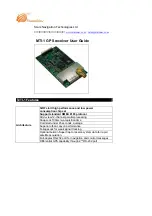
CAP 413
Radiotelephony Manual
Chapter 10 Page 8
3.8
Phraseology for Fixed-Wing VTOL Operations
The following terms are used for VTOL operations:
Pilots of VTOL aircraft should be aware that the terms above may not be in regular
use at aerodromes that do not operate VTOL aircraft. Therefore, pilots should
anticipate that the terms may not be understood by ATC. In such circumstances pilots
of VTOL aircraft are to revert to standard NATO procedures and phraseology for
standard circuits/patterns.
3.9
Emergency Messages
Emergency messages from military pilots differ from civil emergency messages, and
are detailed in JSP 552 Section 700.
3.10
Flameout/Engine Failure – Aerodrome Phraseology
In a real flameout or engine failure situation the appropriate emergency message will
be passed by the aircraft along with the statement of intent for a flameout recovery.
The phraseology to be used when radar is available to the controller is detailed at
paragraph 3.27.
Table 5
Conventional
Landing
A practice, or actual aircraft systems emergency landing, when nozzles
are used for braking and the aircraft will roll for approximately 5000 ft. In
the event of immovable nozzles, a conventional landing may require the
whole runway and engagement of the barrier.
Slow Landing
A normal landing (120 knots) at an intermediate nozzle (normally 65º) and
involving a considerable ground roll which is arrested by power nozzle
braking.
RVL
Rolling vertical landing. A steeper, slower approach (50 knots) followed
by an abbreviated ground roll and, normally, no power nozzle braking.
Accel
A rapid throttle opening to ensure engine response correct. Always
carried out before take-off but only declared if significant ground roll is
required.
Translate
A phrase used to cover largely jetborne flight over short distances
between different landing areas.
Press-up
Vertical take-off and landing on the same pad without transition to
wingborne flight.
Mini circuit
In flight jetborne manoeuvring associated with a press-up.
Lift-off
Vertical take-off from a pad followed by transition to wingborne flight.
STO hop
A short take-off followed by a rolling vertical landing in the same
direction.
Into wind
decel
A deceleration into wind prior to a vertical landing.
Pad
An area of concrete for vertical take-off and landing, the surface of which
can withstand nozzle blast.
Mexe
A metal pad constructed of prefabricated interlocking aluminium strips in
the shape of a circle or square, the surface of which can withstand
nozzle blast.
31 March 2011
Summary of Contents for 413
Page 1: ...CAP 413 Radiotelephony Manual Edition 20 www caa co uk Safety Regulation Group ...
Page 2: ......
Page 3: ...CAP 413 Radiotelephony Manual Edition 20 Safety Regulation Group 17 November 2011 ...
Page 6: ...CAP 413 Radiotelephony Manual Amendment Number Amendment Date Incorporated by Incorporated on ...
Page 10: ...INTENTIONALLY LEFT BLANK ...
Page 18: ...INTENTIONALLY LEFT BLANK ...
Page 20: ...INTENTIONALLY LEFT BLANK ...
Page 68: ...INTENTIONALLY LEFT BLANK ...
Page 126: ...INTENTIONALLY LEFT BLANK ...
Page 162: ...INTENTIONALLY LEFT BLANK ...
Page 170: ...INTENTIONALLY LEFT BLANK ...
Page 178: ...INTENTIONALLY LEFT BLANK ...
Page 206: ...INTENTIONALLY LEFT BLANK ...
Page 248: ...INTENTIONALLY LEFT BLANK ...
Page 254: ...INTENTIONALLY LEFT BLANK ...
Page 264: ...INTENTIONALLY LEFT BLANK ...
















































